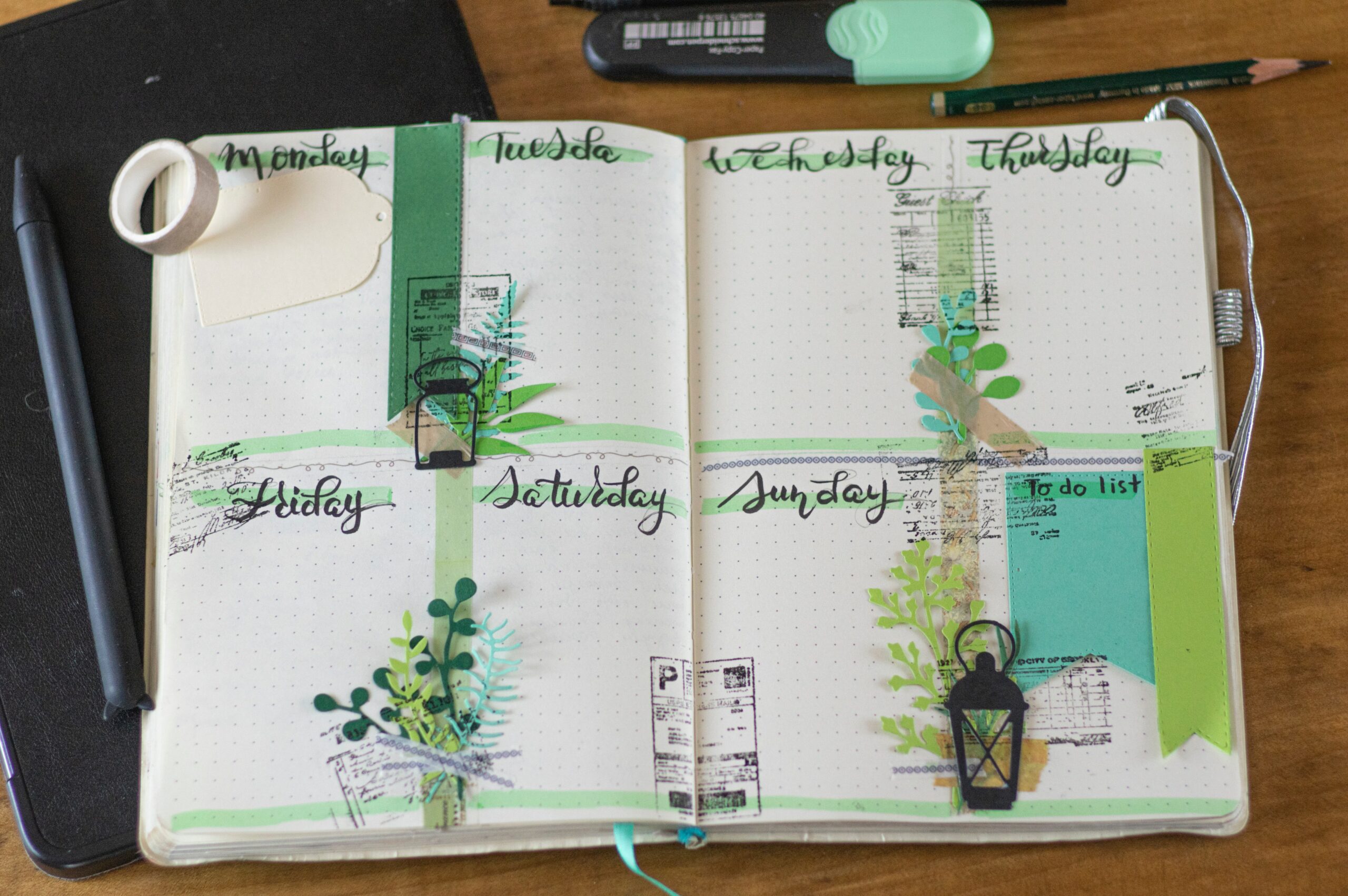As digital nomads, we move around quite a bit, and it might be hard to stay on top of things. We need to not only complete daily tasks such as sending emails and contacting team members but book flights and find good Airbnb deals. We could end up in complete organizational chaos in a matter of days. And it can lead to us missing deadlines, losing clients and forgetting to pay the rent. There are many ways to keep track of personal and professional tasks. But one of the easiest methods is bullet journaling.
Back in 2013, the designer Ryder Carroll developed a bullet journaling method. It unites to-do lists, brainstorming, reminders and other notes into a single notebook, turning your life into a structured system. The goal is to help you reach your professional and personal goals.
Bullet journaling can include several types of lists, but it can also be as simple as writing down your daily tasks and then crossing them out.
Here are some of the reasons why listing daily tasks is important for digital nomads.
Procrastination
Imagine the thrill of moving to another country and being excited about all the adventures coming your way. You settle down, go explore the city, meet new people and get engaged in local social and cultural life. Five days later, you look back, and you have a pile of tasks waiting to be completed before tight deadlines.
As humans, we tend to procrastinate, or in other words, postpone tasks for any possible reason. And as digital nomads, we often end up accumulating some not-so-urgent tasks and later find ourselves in a situation where we have to catch up quite a bit. It happens because we usually prefer immediate rewards to future gains. For example, we won’t miss that afternoon walk but would try to delay writing a report because we don’t immediately see how it can benefit us.
Having a lot to do in a small period of time can be stressful and exhausting. It could affect our mental well-being and deteriorate overall performance.
While there is no easy fix for procrastination, bullet journaling can mitigate its impact. If you prefer journaling in the morning, then it sets you up for the day and gets you organized. And if you are one of those people who write to-do lists in the evening, then you step into the day with a clear mindset and goals. When you have a to-do list ready to go, you feel more pressure to start crossing those tasks off the page. It eventually leads to less procrastination and a more productive working schedule.
Priorities

Have you ever opened your computer not knowing where to start? What task to complete first, and what is less urgent and important? We have all been there. As digital nomads, we are flooded with many personal and professional tasks and tend to get confused and overwhelmed. It leads to a decrease in productivity and motivation and slows down our daily work.
Bullet journaling can be an effective way to look closely at your to-do list and follow your personal agenda. This way you won’t lose time thinking about what you have to do today and what needs to be completed first. But be careful not to overdo bullet journaling by writing down every single tiny task. You will find joy by crossing those tasks off the page, but you won’t get the job done.
Work-life balance

One of the biggest advantages of being a digital nomad is the freedom that comes with this career path. The freedom of where to live, when to work and how to manage your hours. Whether you choose to sit in a home office or spend your day at a co-working space near your Airbnb – the choice is yours. But the paradox is that one of the biggest advantages of this lifestyle can also become a major drawback.
Imagine a day with no clear schedule and no specific to-do list: you wake up in the morning, take your time and start responding to emails somewhere at noon. Two hours later you decide to have a lunch break in the nearest café, which turns into an hours-long city walk. In the evening, you open your computer, remember tomorrow’s deadline, and end up working up until 3 a.m. The next day you feel exhausted and decide to take the morning off. And here, the circle starts again.
Now imagine a day when you wake up and have a clear to-do list, on paper or digitally. Logically you would sit down and start completing those tasks one by one. You might take a lunch break somewhere in between, but you are likely to get back to your list after an hour. As you complete most of the tasks, you will probably decide it’s time to end a working day and take a walk or see some friends.
Bullet journaling cannot solve your work-life balance problem if you never follow a schedule or tend to work overtime every single day. But it can certainly help you stay organized, have enough time for personal staff and take care of your well-being.
Productivity

As digital nomads, we are responsible for our productivity and how it affects our performance. When you constantly move and have to deal with a lot of distractions, staying highly productive might be a challenge. From numerous notifications on your phone to traffic noises or house choirs, the list goes on. And without a clear structure for the day, we might end up switching from one thing to the other many times. When this happens, we do not fully engage in those tasks, part of our attention remains on the previous thing that we were doing. As a result, we are less productive, struggle with time management and cannot make the deadlines.
Bullet journaling brings structure to your day. The trick here is to allow you to list tasks in a visual and organized format. The job is easy: you check the completed tasks and move on to the next ones. Now imagine seeing those undone tasks or the ones you have been dragging around for weeks. Once you see them, you are more likely to get things done and mark the list as complete. The feeling of satisfaction and achievement motivates us to complete those tasks.
Writing your daily tasks boost your productivity in exchange for taking up some of your time. The same way as exercise, meditation, outside walks, cleaning, etc. You make an investment, and, in return, you get more things done. It’s up to you how much time you spend filling your journal. Some people prefer to make simple lists, while others are more creative and make drawings, schemes, mind maps and other visual elements. Try to find the way that fits your lifestyle and personality the best.
Starting bullet journaling as a digital nomad
There is no specific time for listing your daily tasks. Many people integrate this activity into their morning routines because it helps them start the day with a clear mind. Others prefer to write down some tasks before they go to bed late at night and maybe add a couple more in the morning. Whatever works for you would be the best way to go.
It’s important to remember that bullet journals are not just for your work to-do lists and ideas. Instead, this system allows the integration of your personal and professional lives. Along with your deadlines, notes and working tasks, you could also have a meal planner, exercise tracker, reading list, bucket list and others.
Listing your tasks and habits might be a good way to track patterns in your life and notice important changes. You might be missing out on sleep and not notice it or go through a month without a single exercise. Being aware of bad habits can help you move towards a positive change in your health and lifestyle.
Here is what you can add to your bullet journals, apart from daily to-do lists:
Monthly to-do lists

Compared to daily to-do lists, monthly to-do lists help you focus on long-term goals that you want to achieve towards the end of that month. For example, if your daily task is to learn digital marketing for an hour, your monthly task would be to complete an online course. Taking a step back and looking at the bigger picture would help you prioritize well and focus on long-term goals.
Weekly spread
This is the part of the journal where you write daily deadlines, calls, meetings, appointments, etc. It allows you to look at the entire week, prioritize tasks and plan each day accordingly. And once we week is over, you can look back and see which days were hectic and when you had the free time. The weekly overview will help you find time for unexpected meetings and appointments.
Habit tracker
Mastering habits takes time and patience and often, we give up when we are just about to succeed. Try making a habit tracker part of your bullet journal. Write several habits you want to master and mark those days when you practised them. With visual representation, it will become clear which habits you struggle with the most. A trick is to make your habits as specific as possible and place them in your calendar. For example, instead of writing “exercise”, write “exercise for 30 minutes after breakfast”. You are more likely to practice those habits that have a place in your daily schedule.
Gratitude page
The gratitude page can be very personal, and it’s not everyone’s cup of tea. But it can be an effective way to be grateful for opportunities and achievements in your life. Some choose to write a sentence every day others prefer to complete it whenever they feel like it. There is no one structure to the gratitude page, what matters is that you give yourself rewards and also, think about where you can improve further.
“Brain dump”

Sometimes the best ideas come to us at a very unexpected time. And if we do not write them down, we might never remember them. Bullet journals can be used to record those ideas in a trusted system and in a visual way. Then you will have all the ideas in one place for future reference and planning. Looking at them might inspire new ideas and important developments in your professional and personal life.
Travelling planning list
As digital nomads, we travel quite frequently. And having a special list dedicated to this activity seems like a wise thing to do. It can include your next destinations, flights, co-working spaces to explore, best neighbourhoods, cost of living, etc.
Best alternatives to paper
If you are one of those people who prefers to use digital tools instead of an old-school notebook, here are a couple of options you can explore.
With Bullet, you can assign tasks for specific days, weeks, months or even years. It helps you find your tasks easier by grouping them with tags and lists.
Todoist is used by more than 20 million people, for planning and organizing. It allows you to quickly create lists, add recurring due dates, set reminders and priority levels and provides priority visualizations.
Evernote allows you to not only save typed lists but scan handwritten notes, images, web pages, audio, etc. And you can sync your information on multiple devices.
Gris Diary uses a unique grid format to make things easier and allows for the creation of multiple journals with weekly, monthly or yearly timelines.
The Verdict
Listing your tasks and long-term goals can have a positive impact on your success. It can boost your creativity and productivity, improve your time management and help you develop healthy habits. Bullet journaling allows you to not only smoothly run your working schedule but stay on top of things in your personal life. To the point when people will ask you: “What’s your secret?”.












